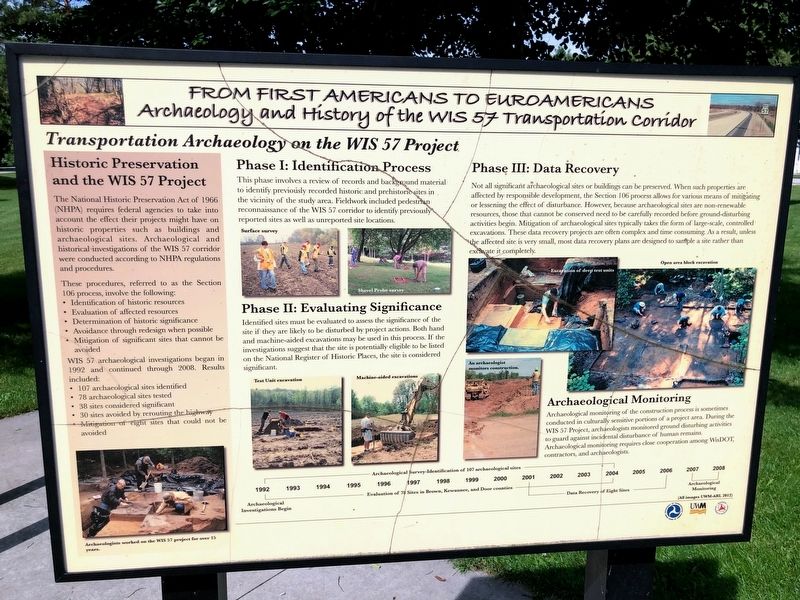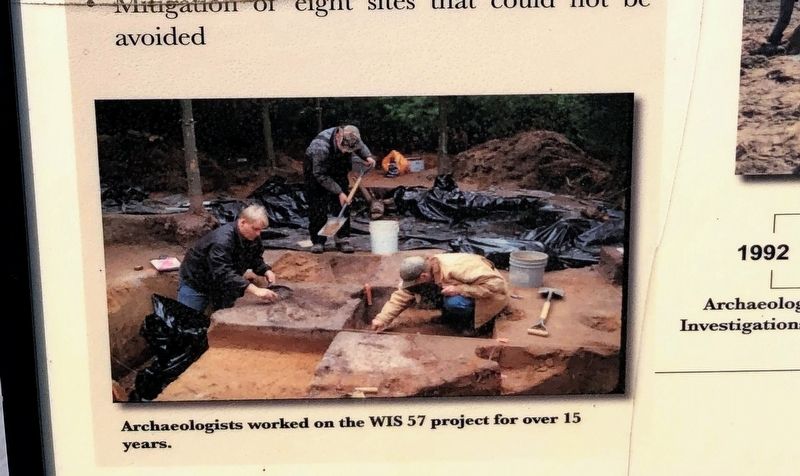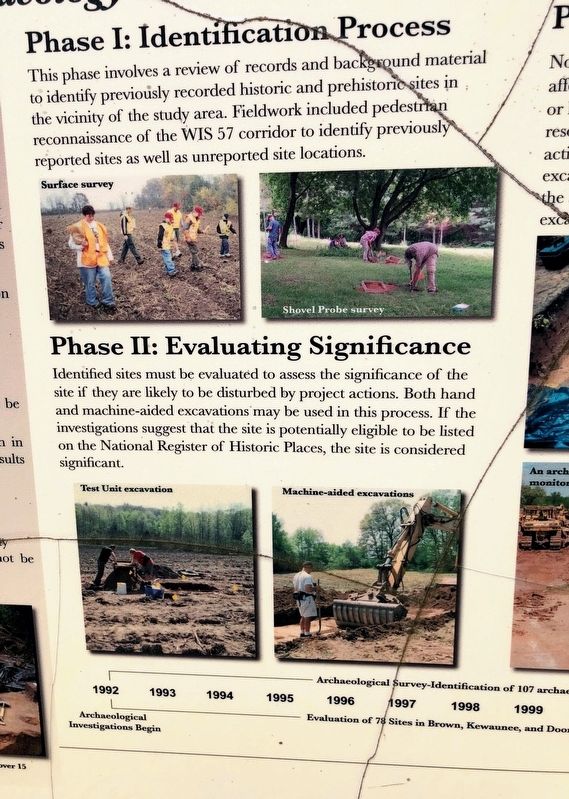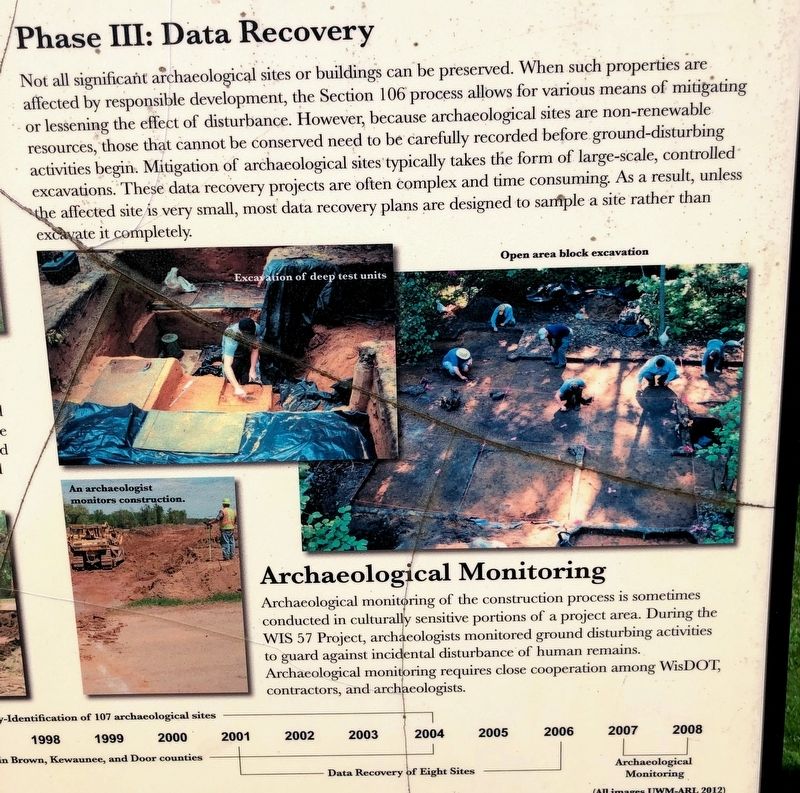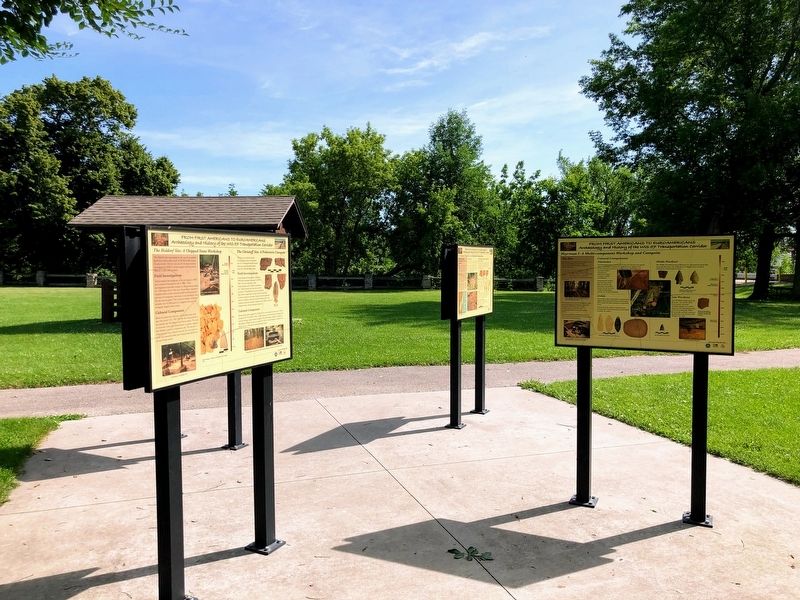Transportation Archaeology on the WIS 57 Project
From First Americans to Euroamericans
— Archaeology and History of the WIS 57 Transportation Corridor —
The National Historic Preservation Act of 1966 (NHPA) requires federal agencies to take into account the effect their properties might have on historic properties such as buildings and archaeological sites. Archaeological and historical investigations of the WIS 57 corridor were conducted according to NHPA regulations and procedures.
These procedures, referred to as the Section 106 process, involve the following:
•Identification of historic resources
•Evaluation of affected resources
•Determination of historic significance
•Avoidance through redesign when possible
•Mitigation of significant sites that cannot be avoided
WIS 57 archaeological investigations began in 1992 and continued through 2008. Results included:
•107 archaeological sites identified
•78 archaeological sites tested
•38 sites considered significant
•30 sites avoided by rerouting the highway
•Mitigation of eight sites that could not be avoided
Phase I: Identification Process
This phase involves a review of records and background material to identify previously recorded historic and prehistoric sites in vicinity of the study area. Fieldwork included pedestrian reconnaissance of the WIS 57 corridor to identify previously reported sites as
Phase II: Evaluating Significance
Identified sites must be evaluated to assess the significance of the site if they are likely to be disturbed by project actions. Both hand and machine-aided excavations may be used in this process. If the investigations suggest that the site is potentially eligible to be listed on the National Register of Historic Places, the site is considered significant.
Phase III: Data Recovery
Not all significant archaeological sites or buildings can be preserved. When such properties are affected by responsible development, the Section 106 process allows for various means of mitigating or lessening the effect of disturbance. However, because archaeological sites are non-renewable resources, those that cannot be conserved need to be carefully recorded before ground-disturbing activities begin. Mitigation of archaeological sites typically takes the form of large-scale, controlled excavations. These data recovery projects are often complex and time consuming. As a result, unless the affected site is very small, most data recovery plans are designed to sample a site rather than excavate it completely.
Archaeological Monitoring
Archaeological monitoring of the construction process is sometimes conducted in culturally sensitive portions of a project area. During the WIS 57
Erected by University of Wisconsin-Milwaukee, U.S. Department of the Interior, Wisconsin Department of Interior.
Topics. This historical marker is listed in these topic lists: Anthropology & Archaeology • Native Americans • Roads & Vehicles.
Location. 44° 34.083′ N, 87° 52.779′ W. Marker is in Scott, Wisconsin, in Brown County. This marker is part of the group of markers at this location titled From First Americans to Euroamericans: Archaeology and History of the WIS 57 Transportation Corridor. The markers are a few steps from the southern parking lot in the Wequiock Falls County Park. Touch for map. Marker is at or near this postal address: 3426 Bay Settlement Road, Green Bay WI 54311, United States of America. Touch for directions.
Other nearby markers. At least 8 other markers are within walking distance of this marker. The Holdorf Site: A Chipped Stone Workshop/The Christoff Site: A Prehistoric Campsite (here, next to this marker); The WIS 57 Reconstruction Project in Brown, Kewaunee, and Door Counties (here, next to this marker); Delfosse-Allard: A Multi-component Site (here, next to this marker); From First Americans to Euroamericans (here, next to this marker); Fabry Creek (Boss Tavern): A Multi-component Site (here, next to this marker); Heyrman I: A Multi-component Workshop and Campsite (here, next to this marker); The Beaudhuin Village Site: A North Bay Middle Woodland Camp (here, next to this marker); Red Banks (about 500 feet away, measured in a direct line). Touch for a list and map of all markers in Scott.
Credits. This page was last revised on June 14, 2020. It was originally submitted on December 7, 2019, by Devon Polzar of Port Washington, Wisconsin. This page has been viewed 182 times since then and 8 times this year. Photos: 1, 2, 3, 4, 5, 6. submitted on December 7, 2019, by Devon Polzar of Port Washington, Wisconsin. • Mark Hilton was the editor who published this page.
